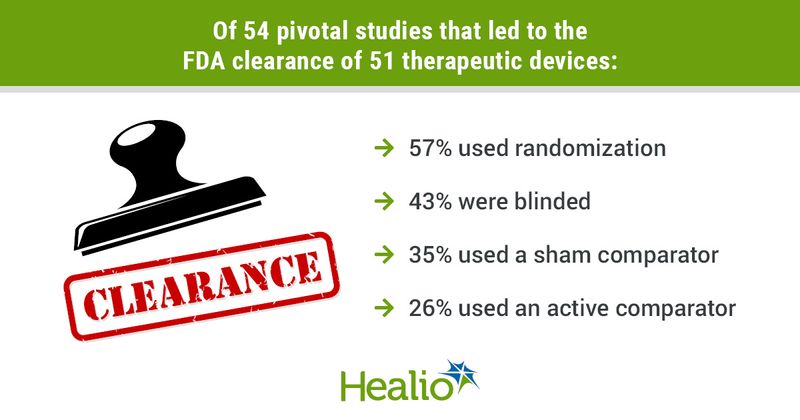Nearly 20% of therapeutic devices cleared without pivotal clinical study
Almost 20% of moderate-risk, nonimplantable, nonlife-sustaining therapeutic devices cleared by the FDA through its de novo pathway did not undergo a pivotal study, data show.
For this cross-sectional study, James L. Johnston, BS, a student at Yale School of Medicine, and colleagues reviewed publicly available FDA databases and decision summary documents to identify and characterize pivotal clinical studies on 63 devices the FDA cleared between Jan. 1, 2011, and Dec. 31, 2019. Most devices served a neurological purpose, but others could be used for gastroenterological, urological, otolaryngological, ophthalmological and general plastic surgery needs.

Of the 51 nonimplantable devices they reviewed, researchers found that FDA clearance was based on 54 pivotal studies. However, 19% of these devices were not evaluated through such studies.
The median number of patients enrolled in the 54 pivotal studies was 112.5 (interquartile range [IQR] = 73.5–187). Also, 57% of the pivotal studies used randomization; 43% were blinded; 35% used a sham comparator; and 26% used an active comparator.
Among 60 studies that gauged premarket effectiveness, 60% had clinical outcomes as primary effectiveness end points; 31% failed to meet at least one primary effectiveness end point; and one device required an FDA postmarket study. Among all 63 devices, 51% provided the foundation for devices subsequently cleared through the FDA’s 510(k) process (median days to first clearance, 202 [IQR =159-302)], including 25% that laid the groundwork for competitor devices clearance (median days to first clearance, 364 [IQR = 184.5-632]).
“To ensure that better evidence is generated to guide clinical decision-making, the FDA could require that devices cleared through the de novo pathway meet prespecified effectiveness end points for clearance and that postmarket studies include larger patient populations,” Johnston and colleagues wrote in JAMA Internal Medicine.
